
Emilio Aguinaldo y Famy was born into the local elite of Cavite on the Island of Luzon in the Philippines. His father had been mayor of Kawit (Cavite viejo) at the time of his death in 1878, a post Aguinaldo himself would hold in 1895. That same year Aguinaldo joined the secret, nationalist brotherhood Katipunan founded by Andrés Bonifacio. After the Philippines erupted in revolt against the Spaniards in 1896, Aguinaldo won several victories in Cavite Province. When Bonifacio came out of hiding in March 1897 and tried to reassert his leadership of Katipunan, Aguinaldo ordered his arrest, imprisonment, and eventual execution on May 10, 1897.
 | |||||||||
| Manuel Luis Quezón y Molina (August 19, 1878 – August 1, 1944) served as president of the Commonwealth of the Philippines from 1935 to 1944. He was the first Filipino to head a government of the Philippines. Quezón is considered by most Filipinos to have been the second president of the Philippines, after Emilio Aguinaldo (1897–1901). |

José Paciano Laurel y García (March 9, 1891 – November 6, 1959) was the president of the Republic of the Philippines, a Japanese-sponsored administration during World War II, from 1943 to 1945. Since the administration of Diosdado Macapagal (1961–1965), Laurel has been recognized as a legitimate president of the Philippines.
Sergio Osmeña y Suico (September 9, 1878 – October 19, 1961) was the President of the Philippines from 1944 to 1946. He was Vice President under Manuel L. Quezon, and rose to the presidency upon Quezon's death in 1944, he is also the first Visayan President. He was a founder of Nacionalista Party.
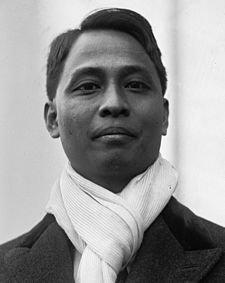
Manuel Acuña Roxas (January 1, 1892 – April 15, 1948) was the first president of the independent Third Republic of the Philippines and 5th president overall. He served as president from the granting of independence in 1946 until his abrupt death in 1948. His term as Philippine president is also the shortest; 1 year 10 months and 18 days.
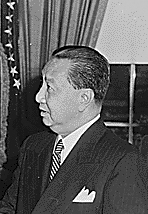
Elpidio Rivera Quirino (November 16, 1890 – February 29, 1956) was a Filipino politician, and the sixth President of the Philippines.
A lawyer by profession, Quirino entered politics when he became a representative of Ilocos Sur from 1919 to 1925. He was then elected as senator from 1925-1931. In 1934, he became a member of the Philippine independence commission that was sent to Washington, D.C., which secured the passage of Tydings-McDuffie Act to American Congress.

Ramón del Fierro Magsaysay (August 31, 1907 - March 17, 1957) was the third President of the Republic of the Philippines (and 7th president overall) from December 30, 1953 until his death in a plane crash in 1957. He was elected President under the banner of the Nacionalista Party

Carlos Polestico García (November 4, 1896 – June 14, 1971) was a Filipino teacher, poet, orator, lawyer, public official, and guerrilla leader. He became the 8th President of the Philippines known for his "Filipino First" policy, which put the interests of the Filipino people above those of foreigners and of the ruling party.
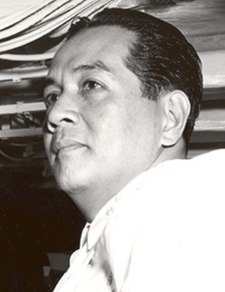
Diosdado Pangan Macapagal (September 28, 1910 – April 21, 1997) was the 9th President of the Philippines, serving from 1961 to 1965, and the 6th Vice President, serving from 1957 to 1961. He is sometimes referred to as the Poor Boy from Lubao, Champion of the Common Man and The Incorruptible. His daughter, Gloria Macapagal-Arroyo served as president of the Philippines from 2001-2
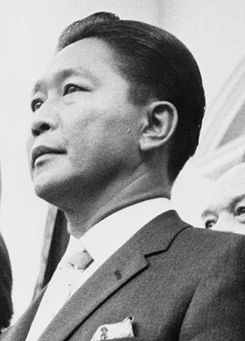 | ||||
| Ferdinand Emmanuel Edralin Marcos (September 11, 1917 – September 28, 1989) was 10th President of the Philippines from 1965 to 1986. He was a lawyer, member of the Philippine House of Representatives (1949–1959) and a member of the Philippine Senate (1959–1965). He was Senate President from 1963-1965. He claimed to have led a guerrilla force called Ang Maharlika in northern Luzon during the Second World War, something much doubted however to be true.[ | ||||
 | ||||
| Maria Corazon Sumulong Cojuangco-Aquino (January 25, 1933 – August 1, 2009) was the 11th President of the Philippines and the first woman to hold that office. Aquino was also the first popularly and democratically-elected female president and head of state in Asia.[1][2] She is best remembered for leading the 1986 People Power Revolution, which toppled Ferdinand Marcos and restored democracy in the Philippines. | ||||
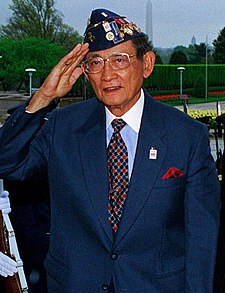 | ||||
| Fidel "Eddie" Valdez Ramos (born March 18, 1928), popularly known as FVR, was the 12th President of the Philippines from 1992 to 1998. During his six years in office, Ramos was widely credited and admired by many for revitalizing and renewing international confidence in the Philippine economy. | ||||
 | ||||
| Joseph "Erap" Estrada (born Jose Marcelo Ejercito on 19 April 1937) was the 13th President of the Philippines, serving from 1998 until 2001. Estrada was the only president to have resigned[1][2] from office and was the first person in the Post-EDSA era to be elected both to the presidency and vice-presidency. | ||||
 | ||||
| Maria Gloria Macapagal-Arroyo (born April 5, 1947) is a Filipino politician who served as the 14th President of the Philippines from 2001 to 2010, as the 12th Vice President of the Philippines from 1998 to 2001, and is currently a member of the House of Representatives representing the 2nd District of Pampanga. She was the country's second female president (after Corazón Aquino), and the daughter of former President Diosdado Macapagal | ||||
 | ||||
| Benigno Simeon Cojuangco Aquino III[1] (pronounced [bɛˈniɡno aˈkino] in most Philippine languages, /bɛˈnɪɡnoʊ əˈkiːnoʊ/ in English) (born February 8, 1960), also known as Noynoy Aquino or PNoy, is a Filipino politician who has been the fifteenth and current President of the Philippines since June 2010. | ||||


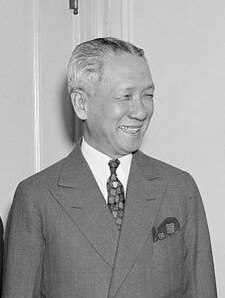
No comments:
Post a Comment